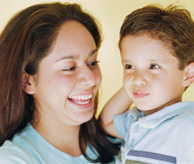
Autism Assessment
Patients with autism have three areas of problems:
1. Social Symptoms
Most children with ASD seem to have tremendous difficulty learning to engage in the give-and-take of everyday human interaction. Even in the first few months of life, many do not interact and they avoid eye contact. They seem indifferent to other people, and often seem to prefer being alone. They may resist attention or passively accept hugs and cuddling. Later, they seldom seek comfort or respond to parents' displays of anger or affection in a typical way. Research has suggested that although children with ASD are attached to their parents, their expression of this attachment is unusual and difficult to "read." To parents, it may seem as if their child is not attached at all. Parents who looked forward to the joys of cuddling, teaching, and playing with their child may feel crushed by this lack of the expected and typical attachment behavior.
Children with ASD also are slower in learning to interpret what others are thinking and feeling. Subtle social cues—whether a smile, a wink, or a grimace—may have little meaning. To a child who misses these cues, "Come here" always means the same thing, whether the speaker is smiling and extending her arms for a hug or frowning and planting her fists on her hips. Without the ability to interpret gestures and facial expressions, the social world may seem bewildering. To compound the problem, people with ASD have difficulty seeing things from another person's perspective. Most 5-year-olds understand that other people have different information, feelings, and goals than they have. A person with ASD may lack such understanding. This inability leaves them unable to predict or understand other people's actions.
Although not universal, it is common for people with ASD also to have difficulty regulating their emotions. This can take the form of "immature" behavior such as crying in class or verbal outbursts that seem inappropriate to those around them. The individual with ASD might also be disruptive and physically aggressive at times, making social relationships still more difficult. They have a tendency to "lose control," particularly when they're in a strange or overwhelming environment, or when angry and frustrated. They may at times break things, attack others, or hurt themselves. In their frustration, some bang their heads, pull their hair, or bite their arms.
2. Communication Difficulties
By age 3, most children have passed predictable milestones on the path to learning language; one of the earliest is babbling. Some children diagnosed with ASD remain mute throughout their lives. Some infants who later show signs of ASD coo and babble during the first few months of life, but they soon stop. Others may be delayed, developing language as late as age 5 to 9. Some children may learn to use communication systems such as pictures or sign language.
Those who do speak often use language in unusual ways. They seem unable to combine words into meaningful sentences. Some speak only single words, while others repeat the same phrase over and over. Some ASD children parrot what they hear, a condition called echolalia. Although many children with no ASD go through a stage where they repeat what they hear, it normally passes by the time they are 3.
Some children only mildly affected may exhibit slight delays in language, or even seem to have precocious language and unusually large vocabularies, but have great difficulty in sustaining a conversation. The "give and take" of normal conversation is hard for them, although they often carry on a monologue on a favorite subject, giving no one else an opportunity to comment. Another difficulty is often the inability to understand body language, tone of voice, or "phrases of speech." They might interpret a sarcastic expression such as "Oh, that's just great" as meaning it really IS great.
3. Repetitive Behaviors
Although children with ASD usually appear physically normal and have good muscle control, odd repetitive motions may set them off from other children. These behaviors might be extreme and highly apparent or more subtle. Some children and older individuals spend a lot of time repeatedly flapping their arms or walking on their toes. Some suddenly freeze in position.
As children, they might spend hours lining up their cars and trains in a certain way, rather than using them for pretend play. If someone accidentally moves one of the toys, the child may be tremendously upset. ASD children need, and demand, absolute consistency in their environment. A slight change in any routine—in mealtimes, dressing, taking a bath, going to school at a certain time and by the same route—can be extremely disturbing. Perhaps order and sameness lend some stability in a world of confusion.
Repetitive behavior sometimes takes the form of a persistent, intense preoccupation. For example, the child might be obsessed with learning all about vacuum cleaners, train schedules, or lighthouses. Often there is great interest in numbers, symbols, or science topics.
NIMH

